|  ying on a sofa in a grey house suit, nestled in German pillows....
he used to fiddle with some small object, his old black
snuffbox, its lacquer gone tarnished...." That was
how Russkie Vedomosti (The Russian Gazette) described russian
writer Ivan Turgenev in 1884. History has, surprisingly,
preserved for us Turgenev's favorite plaything. When leaving,
for the last time, Russia for Paris, where he was not allowed
to smoke or snuff tobacco, Turgenev left his snuffbox as
a souvenir with his friend, writer Yakov Polonsky. The Polonsky
family carefully stored that relic, which was then transferred
to the Pushkin House, that is, the Museum of the Russian
Literature Institute. Turgenev's snuffbox is still on display
at that museum. It is a small oblong black lacquer box,
the size of two matchboxes. Its lid is decorated with a
picture of a sledge driven by three horses, flying along
the snow-laden field. Smartly dressed rosy-cheeked young
ladies are riding in the sledge, with a spirited coachman
whipping the healed horses. Inside the purple-lacquer coaled
lid bears a semi-obliterated picture of a gold double-headed
eagle with the letters "F. A. L." (Alexander Lukutin's
factory trademark) underneath.
ying on a sofa in a grey house suit, nestled in German pillows....
he used to fiddle with some small object, his old black
snuffbox, its lacquer gone tarnished...." That was
how Russkie Vedomosti (The Russian Gazette) described russian
writer Ivan Turgenev in 1884. History has, surprisingly,
preserved for us Turgenev's favorite plaything. When leaving,
for the last time, Russia for Paris, where he was not allowed
to smoke or snuff tobacco, Turgenev left his snuffbox as
a souvenir with his friend, writer Yakov Polonsky. The Polonsky
family carefully stored that relic, which was then transferred
to the Pushkin House, that is, the Museum of the Russian
Literature Institute. Turgenev's snuffbox is still on display
at that museum. It is a small oblong black lacquer box,
the size of two matchboxes. Its lid is decorated with a
picture of a sledge driven by three horses, flying along
the snow-laden field. Smartly dressed rosy-cheeked young
ladies are riding in the sledge, with a spirited coachman
whipping the healed horses. Inside the purple-lacquer coaled
lid bears a semi-obliterated picture of a gold double-headed
eagle with the letters "F. A. L." (Alexander Lukutin's
factory trademark) underneath.
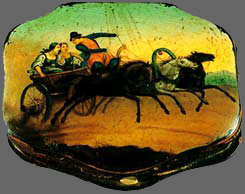
Cigare-case "Messenger"
Pyotr Lukutin factory. 1825-1828
|
The village
of Fedoskino, situated 40km north of Moscow on the picturesque
banks of the Ucha River, is Russia's oldest centre of lacquer
miniature painting. At least half of the inhabitants of
this village and the neighboring ones are in one way or
another connected with the traditional craft. The secrets
of making and painting papier-mache lacquers have for 200
years now been passed from one generation to another. The
French word "papier-mache" (literally "chewed
paper") is well-rooted in the Russian language. Several
layers of pasted cardboard, boiled in linseed oil and then
repeatedly dried in a hot oven, form an original material
- hard as wood, light and waterproof - that can be sawed,
polished, primed and lacquered. In the 18lh through the
19lh century papier-mache was widely used to make sundry
items from peaks for the Russian army headdress to trays,
tables and even chandeliers. Needless to say, all sorts
of papier-mache caskets and boxes used to store matches,
stamps, cards, glasses and above all snuff were immensely
popular.
The best jewelers were commissioned
to make snuffboxes, which at limes cost a fortune. By the
end of the 18th century snuffing had become widespread -
every shop-assistant thought it a matter of self-esteem
to have a snuffbox near at hand. Demand for inexpensive
mass-produced snuffboxes was on the rise, and papier-mache
proved a suitable material. A host of small factories engaged
in making snuffboxes in Russia at that time. Among others,
Moscow merchant Pyotr Korobov also founded one such factory
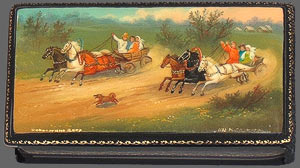
N.Leonova "Troika". Casket. 1992
|
Pyotr Korobov's
factory was the first in the Moscow region. According to
legend, Korobov went to Germany to visit Johann Stobwasser's
factory in Braunschweig and brought back round painted snuffboxes
to serve as models. The first trademark appeared on the
factory products under Pyotr Lukutin, Korobov's son-in-law
who inherited the factory in 1824. His trademark consisted
of the letters "F. P. L." which stood for "Factory
Pyor Lukutin." From that time and throughout the 19th
century until the factory was closed in 1904, the Lukutin
family owned the factory. In 1828, Pyotr Lukutin was conferred
the right to stamp his products with the state emblem. The
double-headed Russian eagle thus appeared next to the "F.
P. L." initials.
Alongside plain, mass-produced
items intended for the public at large and supplied to trade
rows or shops, the Lukutin factory also made things to order
intended for wealthy merchants and the aristocracy. Executed
with rare craftsmanship and delicacy, those products brought
fame to Lukutin's artisans in the first half of the 19th
century.Miniature painting was also on the rise in the applied
arts, especially porcelain painting (Gardner's porcelain
factory, which was located comparatively not far from Fedoskino,
is worth mentioning in this connection), in which genre
scenes and pictures of peasant and round dances were in
vogue, together with portraits and landscapes. Lukutin's
papier-mache lacquer miniatures were well-attuned to their
time. Their conventional black background, small size, planar
composition, romantic and allegorical scenes or sentimental
portraits met perfectly well the aesthetic criteria of the
age.

N.Ivanova "The masters of Zostovo". Casket. 2004
|
Rivals to the
Korobov - Lukutin factory appeared early in the 19th century.
Count Sheremetev's serfs, Yegor and Taras Vishnyakov, opened
their workshops in neighboring Zhostovo and Ostashkovo,
respectively, in 1815 and 1816. By the early 1850s, twelve
lacquer workshops were operating in Zhostovo and nearby
villages. The workshop of Osip Filippovich Vishnyakov soon
captured the leading position in the trade. His earlier
known works dale to the 1830s through the 1850s. They bear
the trademark "Master O. F. Vishnyakov" inscribed
in a circle.The history of two outstanding lacquer productions
in the Moscow region - the Lukutin and Vishnyakov workshops
- closely intertwined throughout the 19th century. They
competed with and influenced each other, exchanging craftsmen
and production techniques.
Lacquer miniatures of the
Moscow region were made with the help of multi-layer oil
painting on the primed papier-mache surface with special
linin. Most of the Fedoskino papier-mache wares have a black
background on Ihe outside and are covered inside with scarlet,
bright-red or cherry-colored lacquer. Papier-mache lacquers
of the Moscow region were closely linked to Russia's graphic
art of that period. Miniature artists mastered and copied
drawings, engravings, cheap folk prints and lithographs
which were sold in separate sheets and albums. Quite a few
works have now been identified as prototypes of miniature
compositions used in lacquers of the Moscow region. The
theme of troika-riding was most widespread in 19th century
miniatures. A troika rushing through the snow-laden forest
and sledge riders are to this day a popular theme that has
become an emblem of the craft.
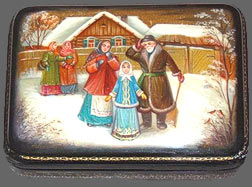
A.Vedernikov "Snow Maiden". Casket. 2000
|
In
1904, Lukutin's heirs (the last, N. A. Lukutin died in 1902)
closed the factory. Some miniature painters transferred
to the Vishnyakov workshop, but many of them were dissatisfied
with the tough working conditions. The Fedoskino Artel of
Former Lukutin Factory Workers was founded in 1910, initially
numbering ten craftsmen, later joined by several more people.
The years of the revolution and the subsequent Civil War
took a heavy toll on the craftsmen and, for that matter,
Russian life in general. Workshops often stood idle as a
result of raw material and other shortages, and there was
little demand for the finished products.
That situation changed noticeably
in 1923, when the Ail-Union Exhibition of Agricultural,
Industrial and Cultural Products in Moscow, where Fedoskino
wares were awarded the first degree diploma "for superb
artistic skill" and another diploma "for preserving
the craft and high cooperation." Artel's products were
exported abroad and sent to international exhibitions. Fedoskino
craftsmen were awarded the Paris Exhibition diploma in 1925
and the Milan Exhibition diploma in 1927.
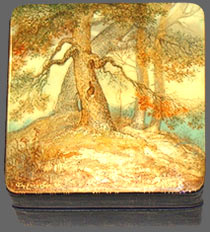
D.Sedov "Forest". Casket. 2003
|
Important
anniversaries of Soviet political and cultural life, which
brought major state orders, became landmarks in the craft's
history. Thus, a major exhibition held in 1937 marked the
centenary of Pushkin's death. A special series of caskets
centered around Pushkinian themes, with paintings by D.
N. Kardovsky, G. C. Chernelsov and G. D. Myasoyedov portraying
Pushkin or illustrating his works used as models. The miniatures
were accomplished by gifted artists from among the early
graduates of the Fedoskino school, including I. Bannov,
K. Zorin, S. Slesarev and N. Smurov, who brilliantly succeeded
in copying academic painting. Many of them, regrettably,
were not destined lo work long: They perished during World
War II.
Throughout the 1940s and 1950s
The artel focused primarily on copying works by Vassily
Perov, Vassily Surikov, Ilya Repin, Ivan Shishkin and other
renowned Russian artists. Some pieces, such as Vasnetsov's
"Alenushka" were easily transposed onto the surface
of caskets. However, as few easel paintings could be adapted
lo the laws of miniature painting, the more creative artists
came up with their own compositions. During that period
V. D. Lipitsky, A. I. Kozlov and M. G. Pashinin emerged
as original artists, who turned to Russian tales, such as
"The Scarlet Flower", "The Tale of Tsar Saltan" and "The Snow
Maiden", which was a new trend for the Fedoskino craft. Ever
since that time Russian tales became a popular theme among
Fedoskino artists, whose poetic images have lost none of
their glamour.
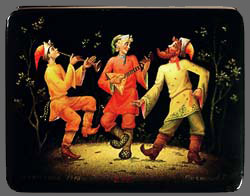
S.Rogatov
Box "Buffoons". 1978
|
Landscape miniatures
gained prominence in the sixties. The artists deftly transform
shimmering mother-of-pearl into glimmering water, sky al
sunset or sunbeams piercing clouds. The winter landscapes
with silvery snow, spring landscapes with a radiant sky
al sunset and autumn landscapes with golden leaves... Traditional
Fedoskino ornamentation of boxes reached extraordinary heights
in the 1980s and 1990s. Today's Fedoskino skan' is incomparably
richer than Lukutin's artless designs. Using a limited set
of figured metal spangles - tiny circles, corners, crescents
and stars - latterday craftsmen create an unlimited number
of ornaments inscribed on the round or oval lid of a box,
girdling its prominent sides or just framing paintings.
Fedoskino painters also continue
to develop genre miniatures. They have shown far more freedom
in recent years in elaborating a multitude of themes. Unrestrained
in conveying their feelings and ideas, they turn out hearty
works of art. Historical and ethnographic themes are being
extensively added to traditional fairy tale, epic song motifs
and illustrations of literary works. The immutable charm
of the native land and continuity of the craft, which earns
the artisans their daily bread and sense of achievement,
account for the longevity of Fedoskino lacquers.
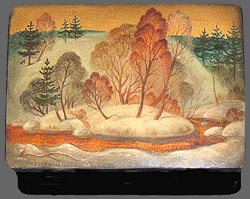
T.Levitskaya "Russian winter". Casket. 1998
|
|